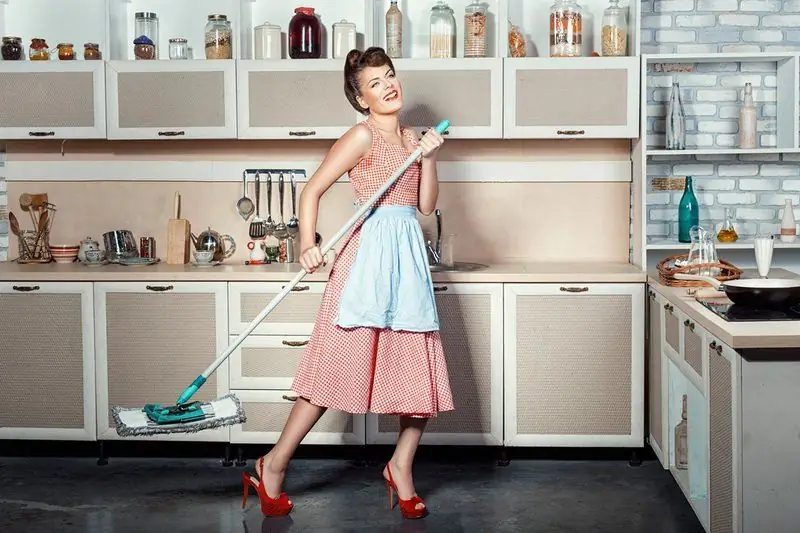
Table of contents:
- Author Bailey Albertson [email protected].
- Public 2023-12-17 12:53.
- Last modified 2025-06-01 07:32.
When to harvest winter and spring garlic: optimal timing

The specific taste with a piquant bitterness is the zest of garlic, which deserved popular love, according to historians, more than 5 thousand years ago. In cooking, medicine and even households, this vegetable of the bulbous family is irreplaceable. The agrotechnology of cultivating an annual crop is not at all complicated, but in order for the garlic to be well stored and remain juicy and aromatic for longer, every gardener tries to choose the right time for harvesting the garlic beds.
Content
-
1 Garlic as a vegetable crop
1.1 How much garlic grows
-
2 When the garlic crop is ready to harvest
- 2.1 Video: how to understand that garlic is ripe
-
2.2 Timing of harvest of winter garlic
2.2.1 Video: when to harvest winter garlic
-
2.3 When spring garlic ripens
2.3.1 Video: Spring Garlic: How to Determine Ripeness and When to Put It in Storage
-
3 Timing of harvesting garlic by region
- 3.1 When garlic is harvested in the Moscow region
- 3.2 Harvesting garlic in the Black Earth Region and the Volga Region
- 3.3 Timing of harvesting garlic in the southern regions
- 3.4 When the harvest of garlic is ready for harvest in Siberia and the Far East
Garlic as a vegetable crop
This herbaceous plant is grown in almost all climatic zones of our country. Garlic feels best in sunny, well-fertilized beds.
An annual crop can be recognized by its narrow foliage, elongated upward, and dense umbrella-shaped inflorescences covered with a whitish shell. Garlic reaches 35-40 cm in height.

Both greens and cloves that form in the onion are suitable for food.
How much garlic grows
The average growing season of the bulbous is 3-4 months, if the weather does not make adjustments to the dacha life. In practice, two types of garlic are cultivated - winter and spring.
- Winter - the vegetation period of the plant is 85-100 days from the moment of emergence, stored for 6-8 months. It has a false stem in the center, the head consists of 4-6 denticles (up to 50 g).
- Spring - the moment of ripening occurs after 110-125 days. It may contain from 8 to 20 small cloves (10-20 g each), there is no false stem.

This is how the head of ripe winter (left) and spring garlic (right) looks like
When the garlic crop is ready for harvest
The growing season of winter and spring crops differs in only 2-3 weeks, but the harvesting period depends on the degree of maturity and varietal characteristics of the crop. First of all, by external signs, you can understand that the garlic is already ripe.
-
The lower leaves dry out and become thin and lethargic.

Garlic in the last stage of ripening Drying lower leaves of garlic indicate its ripening
-
The tips of the remaining leaves turn yellow and curl up.

Garlic turned yellow At the end of the growing season, the green foliage of garlic loses its juiciness, the plant looks wilted
- The stem becomes less elastic and droops.
-
Arrows, rolled into spirals before ripening, on the contrary, flatten and coarse.

Arrows of garlic in early summer and before harvest Arrows of garlic in early summer (left) are usually twisted into a spiral that flattens out as they ripen (right)
-
The thin shell on airy inflorescences partially dries up and bursts.

Ripe puffed garlic bulb Seeds appeared from the cracks of the garlic "bulb" - it's time to dig out the garlic
Cleaning on garlic beds is preceded by the following manipulations:
- a month before digging up on the plant, cut off the arrows (leave 1-2 control ones to determine maturity);
- watering is stopped 2 weeks before the start of harvesting;
- if there is mulch in the beds, it should be removed 20-25 days before the moment when the garlic is fully ripe.

The beds freed from mulch and dried soil are a guarantee that the garlic bulbs will be clean and tidy, they do not have to be thoroughly peeled and dried for a long time
Following (2-3 weeks before harvesting) planting garlic is recommended to loosen. According to many summer residents, this improves air exchange in the soil and accelerates the ripening process by several days. On coarse soil (black soil, loam), the garlic heads dry out thanks to this procedure and are subsequently easier to clean, which simplifies cleaning.
The crop is harvested in dry, cool weather, as a rule, it is best to choose the time for this in the morning hours before 11.00 or in the evening after 17.00
The older generation in my family (grandfather and great-grandfather) have always determined the maturity of garlic "by a tooth", although many would now laugh at this manner. But the degree of ripening was always guessed exactly if the denticles in the scales were dense and did not get bitten the first time. One more thing: when winter garlic ripened, it became "angry", and the juice released on the cuts of the cloves was stickier than that of the young plant.
In our village, the Orthodox holiday of the Holy Apostles Peter and Paul (July 12) has always been a kind of border, which was considered the final growing season of garlic planted before winter. And they tried to dig up the spring one before the Assumption of the Virgin (August 28). As it has been, it is still: I look at the external signs of the ripeness of garlic, and at the calendar.
Video: how to understand that garlic is ripe
Winter garlic harvest time
Since this is an arrowhead species, among other features, the degree of ripeness is always noticeable by the air bulbs located at the tops of the arrows. "Bulbules" inside, "sit" more loosely, their shell becomes darker, tougher to the touch.
In the underground bulb of ripe winter garlic, the scales become dense and rough, acquiring a violet-pearlescent hue. If a garlic head easily divides into cloves when breaking, it means that the garlic is on the verge of overripe
Video: when to harvest winter garlic
When spring garlic ripens
Garlic, planted in spring, sometimes remains green and juicy until frost. Its degree of maturity is easier to determine by the dug head: the scales become coarse and acquire an off-white hue; the teeth are fully formed and clearly visible through the multilayer protective shell.
Partial lodging of the stem and dryness of the neck of the plant indicate the end of the growing season
Video: spring garlic: how to determine maturity and when it is better to store
Terms of harvesting garlic by region
Most gardeners start harvesting a spicy crop closer to mid-summer. Regardless of the climatic characteristics, when spring came late, it was followed by a sultry dry summer, garlic is harvested 7-10 days later. In the event that the summer turned out to be rainy, it is better to dig up the garlic a week earlier. Do not forget that early ripening varieties are harvested 10-14 days earlier than late ones.

As long as the weather permits, it is better to remove the garlic from the beds, you should not wait until the heads rot and the cloves begin to fall apart
Regional features of the climate also make their own adjustments to the timing of garlic harvesting.
When garlic is harvested in the Moscow region
Traditionally, winter varieties in the Moscow region are dug from 12 to 30 July. After 1.5-2 weeks, they start harvesting early spring garlic, late-ripening varieties are dug a week later.
Harvesting garlic in the Black Earth Region and in the Volga Region
The timing of harvesting on garlic beds in Central Russia practically does not differ from the Moscow region. As a rule, the first harvest of garlic planted in winter is dug up from July 10th. Harvesting of spring garlic starts from the 20th of August and lasts until 10-15 September.
Terms of harvesting garlic in the southern regions
Despite the fact that in the south of our country (Crimea, the Caucasus region) the summer season begins early, winter garlic does not ripen until July 5-10. Early spring varieties begin to be dug from the first ten days of August, late ones - 7-10 days later, until the end of September. Often, spring garlic is dug out before harvesting carrots and beets.
When the harvest of garlic is ready for harvest in Siberia and the Far East
In the northern regions, winter garlic fully ripens in the last decade of July, in cool summer - in early August (if you are guided by the summer cottage forums). Spring digging begins in mid-August and continues until the second decade of September, anticipating the first frost.
When choosing the moment to harvest from garlic beds, it is better to focus on the aggregate signs of the maturity of the bulbous head and the weather forecast are the main indicators. The approximate ripening times of winter garlic by region differ by 2-3 weeks, and spring garlic is dug up depending on the planting date. The main thing to remember is that this vegetable should not be overexposed in the beds. Observing the rules of cleaning, you can save the garlic heads until next spring.
Recommended:
How To Choose A Hood For The Kitchen - In Terms Of Power And Other Parameters, What To Look For When Buying A Built-in And Built-in, For A Gas And Electric Stove, Professional Advi

What parameters should you pay attention to when choosing a cooker hood for the kitchen: types of devices, how much the prices differ. Model overview and manufacturer information
Planting Strawberries In Spring In Open Ground: Terms And Instructions

Pros and cons of planting strawberries in open ground in spring, suitable timing. Step-by-step instructions for planting strawberries in spring
Planting Grapes With Cuttings And Seedlings In Spring: Terms And Instructions

When and how grapes are planted in spring, is it better than autumn. How a pit and a seedling are prepared, how is the planting process
Planting Garlic In Spring In Open Ground: When And How To Plant It Correctly, Instructions

How to plant garlic in spring in open ground: step by step instructions for preparing, planting and caring for the crop
Why You Can't Why You Can't Wash Floors On Friday: Signs And Facts

Why you can't wash floors on Friday: signs and superstitions. The opinion of the mystics and Orthodoxy
